Common menu bar links
Breadcrumb Trail
ARCHIVED - Canadian Nuclear Safety Commission
 This page has been archived.
This page has been archived.
Archived Content
Information identified as archived on the Web is for reference, research or recordkeeping purposes. It has not been altered or updated after the date of archiving. Web pages that are archived on the Web are not subject to the Government of Canada Web Standards. As per the Communications Policy of the Government of Canada, you can request alternate formats on the "Contact Us" page.
Message from the President
It is with great pleasure that I submit to Parliament the 2009–10 Report on Plans and Priorities of the Canadian Nuclear Safety Commission (CNSC).
The CNSC is preparing for the future. It must be ready to address existing and new initiatives relating to the refurbishment of aging nuclear power plants; to the applications for new nuclear power plants; to the expanding interest in uranium mining activities; and to the various nuclear applications in health care and industrial radiography.
In the January 26, 2009 Speech from the Throne, the Government of Canada introduced new measures to stimulate the economy and reinforced its commitment to the priorities set out in Fall 2008. The Fall speech outlined Canada’s commitment to securing its energy future and stated specifically that “Nuclear energy is a proven technology, capable of reliable, large-scale output. In Canada and around the world, energy authorities are investing in nuclear power to meet both energy security and climate change goals. Our Government will ensure that Canada’s regulatory framework is ready to respond should the provinces choose to advance new nuclear projects.”
The CNSC will meet its day-to-day regulatory responsibilities, and the new demands being placed on it, by modernizing its regulatory framework and by engaging its government partners, through the Major Projects Management Office, to promote efficiency and regulatory improvements for major projects. Furthermore, through rigorous licensing and compliance processes, the CNSC will work with its international partners to ensure Canada’s security and obligations for international safeguards are met.
The shutdown of Atomic Energy of Canada Limited’s (AECL) National Research Universal (NRU) research reactor in December 2007 demonstrated the importance of the NRU research reactor as a global supplier of isotopes, and the fragility of this supply chain. Following this incident, the CNSC has responded to the recommendations made by Talisman International LLC in its Lessons Learned report. The CNSC is implementing an organization-wide action plan (Harmonized Plan) of improvement initiatives to reinforce commitment tracking, regulatory clarity and good communication.
The CNSC is also implementing a transparent protocol for the re-licensing of the NRU in 2011. This will enable the government, AECL and all Canadians to know clearly and in advance what the CNSC requires to extend the NRU’s operating licence.
The 2009 Budget also commits to strengthening the management of the Public Service. To support this, the CNSC will continue to strengthen its fiscal and human resources management. The CNSC has traditionally been funded exclusively through an annual appropriation from Parliament. However, revenues generated from cost recoverable activities authorized in the Canadian Nuclear Safety Commission Cost Recovery Fees Regulations will now be re-spent through a new revenue spending model. This approach will provide the CNSC with more flexibility to meet regulatory requirements on a sustainable basis.
To meet our future obligations, the CNSC must have staff capacity and expertise to do the job. The CNSC has been successful in attracting new employees over the past two fiscal years. We want to ensure that both new employees and current staff are highly committed to our organization and its objectives. We want to become an employer of choice. We look forward to receiving input from our employees through surveys that have been conducted as we continue to focus on excellence and, where needed, improve our performance. We know that employee development, strong leadership, excellent external/internal client services, and enabling policies and programs will be important elements to achieve our goal of being a top employer.
Canadians can be assured that the CNSC will continue to regulate the nuclear sector to protect the health, safety and security of persons and the environment; and to respect Canada’s international commitments on the peaceful use of nuclear energy. I am confident that the CNSC will continue to fulfill this mandate as it strives to be the best nuclear regulator in the world.
[ original signed by M. Binder ]
Michael Binder
President
SECTION I - CNSC OVERVIEW
1.1 Summary Information
Raison d’être and Responsibilities
Canadian Nuclear Safety Commission’s Mandate
The CNSC regulates nuclear energy and substances in Canada. Through its licensing, certification and compliance processes, the CNSC ensures that nuclear activities are carried out safely, in order to protect people, their health and their environment. The CNSC also works to ensure that Canadians and Canadian companies respect Canada’s international commitments on the peaceful use of nuclear energy.
The CNSC was established in 2000 under the Nuclear Safety and Control Act (NSCA), and reports to Parliament through the Minister of Natural Resources. The agency was created as a successor to the former Atomic Energy Control Board, which was founded in 1946. The CNSC’s mandate, responsibilities and powers are set out in the NSCA. Through the NSCA, regulations, associated regulatory documents, licences and licence conditions, the CNSC regulates the entire Canadian nuclear cycle and all aspects of nuclear safety.
The CNSC regulates:
- Nuclear power plants
- Uranium mines and mills
- Uranium processing and fuel fabrication facilities
- Nuclear research and test facilities and non-power plants
- Nuclear substance processing facilities
- Radioactive waste and waste management facilities
- Hospitals and cancer treatment centres
- Decommissioning of heavy water production plants
The organization is also responsible for:
- regulating the use of nuclear substances and radiation devices, the packaging and transport of nuclear substances, and the import and export of nuclear substances and equipment
- verifying that personnel who hold key safety-related jobs at nuclear facilities are certified
The CNSC also administers the Nuclear Liability Act and, as Responsible Authority under the Canadian Environmental Assessment Act, carries out Environmental Assessments (EAs) for nuclear projects in accordance with this legislation.
The CNSC’s Commission Tribunal has up to seven permanent members, appointed by the Governor in Council and is supported by more than 800 employees. The President of the CNSC is a permanent full-time member, and other members may be appointed to serve full or part-time. Temporary members can also be appointed by the Governor in Council as required. Commission Tribunal members are chosen based on their credentials and are independent of all political, governmental, special interest group or industry influences.
The Commission Tribunal makes independent, fair and transparent decisions on the licensing of nuclear-related activities, makes legally binding regulations, and sets regulatory policy direction on matters relating to health, safety, nuclear security and the environment. With respect to licensing matters related to major nuclear facilities, the Commission Tribunal considers applicant proposals, recommendations of the CNSC personnel, and stakeholder views before making its decisions. To promote openness and transparency, the Commission Tribunal conducts business to the greatest extent possible in public hearings and meetings and, where appropriate, in communities affected by the decision at hand. Tribunal hearings are conducted in a public forum approximately 10 times per year and decisions are released within 30 business days after the closing of the hearings.
The following organizational chart provides additional details.
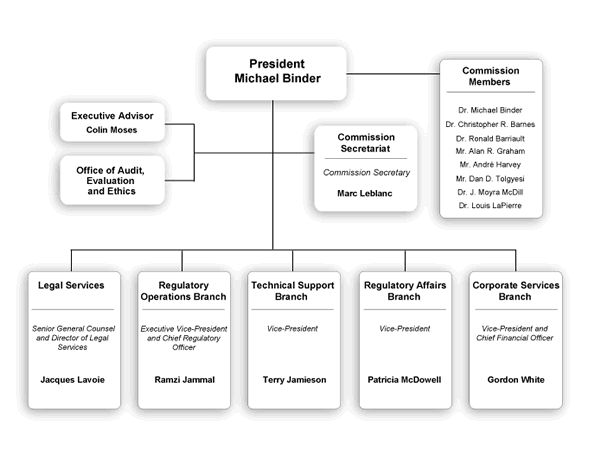
Note:
Dr. J. Moyra McDill’s term expired in late October 2008
Mr. Alan R. Graham’s term expired December 31, 2008
In both cases, these members have been authorized to complete files that had been seized prior to the expiry of their terms.
The following chart illustrates the CNSC’s complete framework of program activities and program sub-activities, which roll up and contribute to the CNSC’s single strategic outcome:
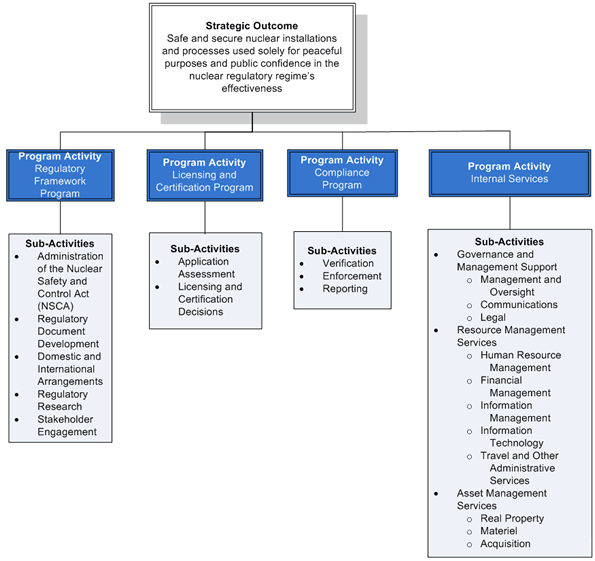
Program Activity Architecture Crosswalk
In Spring 2008, the Treasury Board Secretariat approved the CNSC’s submission for modifying its Program Activity Architecture (PAA) for 2009-10 and beyond.
The purpose of these changes is to more accurately reflect how the CNSC plans, monitors and reports on its performance. This re-alignment resulted in a single, clear planning and reporting framework that presents how the organization manages its programs.
Regulatory framework, licensing and certification, and compliance replaced nuclear regulation as program activities. Cooperative undertakings and stakeholder relations became sub-activities under the regulatory framework program activity. Additional sub-activities as illustrated in the PAA chart on page 11 were added to further define the PAA.
The following table provides a crosswalk for the CNSC’s 2008-09 planned spending to the new PAA.
| ($ thousands) | Strategic Outcome: Safe and secure nuclear installations and processes solely for peaceful purposes; and public confidence in the nuclear regulatory regime’s effectiveness. |
|---|---|
| 2009-10 Strategic Outcome and Program Activities | Nuclear Regulation |
| Safe and secure nuclear installations and processes used solely for peaceful purposes and public confidence in the nuclear regulatory regime’s effectiveness. | |
| Regulatory Framework Program | $27,589 |
| Licensing and Certification Program | $29,873 |
| Compliance Program | $25,474 |
| Internal Services | $34,749 |
| Total 2008-09 Planned Spending | $117,685 |
1.2 Planning Summary
Based on current projections, there is a long term increased need for energy sources in Canada and globally. Nuclear power is seen as a key contributor to meeting that increased demand while avoiding harmful greenhouse gas emissions. This demand is also expected to lead to plans for refurbishing existing nuclear power plants as they come to the end of their operating lives and to investments in new nuclear power facilities. Growth in nuclear energy also affects the entire nuclear fuel cycle from uranium mining and milling, uranium refining and fuel production to long-term management of nuclear waste.
With renewed focus on nuclear power comes the need for the CNSC, as Canada’s nuclear watchdog, to adapt its operations to regulate, license, and ensure compliance with nuclear-related legislation in a simple, clear, and timely fashion to protect the health, safety and security of persons, and the environment. Many responsibilities accompany this need for adaptability. These include strengthening how the CNSC operates, making sure licensees understand requirements, enhancing the CNSC’s capacity and communicating with various stakeholders.
To this end, the CNSC executive team identified priorities for the upcoming planning period. This fiscal year, the priorities are presented under the following four pillars: commitments and ongoing improvements; clarity of our requirements; capacity for action; and communications. These four pillars and their associated priorities support progress towards the CNSC’s strategic outcome.
- Commitments and ongoing improvements
In addition to conducting core licensing and compliance activities, this pillar includes prioritizing and completing outstanding improvement initiatives, plans, and commitments, particularly those resulting from the Talisman Lessons Learned report of 2008. It also includes assessing findings of other audits and evaluations, and ensuring that the health of Canadians and the safety of facilities are central considerations in all licensing and compliance activities through initiatives such as isotope contingency planning and dealing with environmental concerns.
- Clarity of our requirements
This pillar includes creating broad awareness among proponents of the CNSC’s requirements stemming from the NSCA, licensees and vendors of technology related to the CNSC’s requirements, particularly in terms of the initial phases of new builds (for example, design reviews, review guides, joint review panels); revitalizing the CNSC’s regulatory framework; clarifying regulatory documents and guidance, including specific attention to guidance for licence applications and EAs; engaging government partners through the Major Projects Management Office; and continuing the implementation of an improved protocol for NRU licence renewal.
- Capacity for action
This pillar includes maintaining and renewing the CNSC’s workforce to ensure sufficient knowledge and skills to fulfill our mandate. This means continuing efforts to make the CNSC an employer of choice through renewal, retention and recruitment initiatives; fully implementing the new Revenue Spending Authority as the CNSC’s primary funding mechanism; strengthening planning and operational processes; and renewing critical infrastructure (for example, information technology and accommodations).
- Communications
This pillar includes work to strengthen communications with the CNSC’s licensees, stakeholders, Aboriginal peoples, international counterparts, other government departments and central agencies.
The following diagram depicts how the CNSC priorities are aligned to the organization’s program activities and ultimately to its strategic outcome.
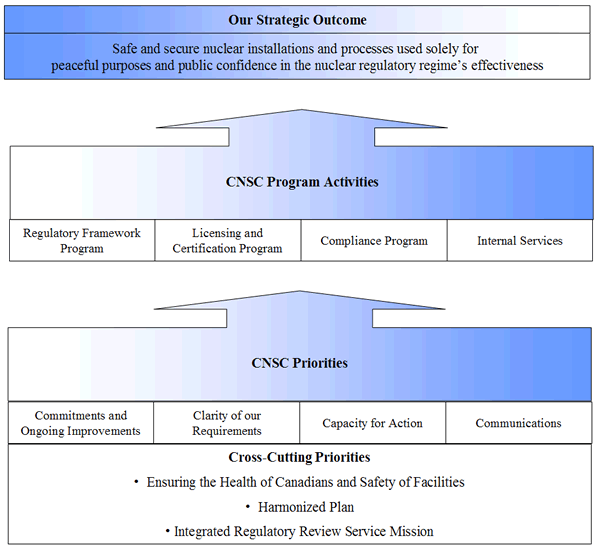
The following table summarizes the links between the CNSC’s strategic outcome, program activities, expected results and Government of Canada outcomes. It also includes estimated planned spending by program activity:
| Performance Indicators | Targets |
|---|---|
| Compliance rating of licensees (for each program) | Satisfactory or better in all safety areas |
| Number of radiation exposures over the allowable limits | Zero reported cases |
| Positive International Atomic Energy Agency (IAEA) Safeguards Conclusion | Positive Annual Safeguards Broad Conclusion for Canada |
| Strategic Outcome: Safe and secure nuclear installations and processes solely for peaceful purposes; and public confidence in the nuclear regulatory regime’s effectiveness. | Estimated Planned Spending* ($ thousands) |
Alignment to Government of Canada Outcome Areas |
|||||||
|---|---|---|---|---|---|---|---|---|---|
| Program Activity1 | Expected Results | 2009-10 | 2010-11 | 2011-12** | |||||
| Expenditures | FTEs | Expenditures | FTEs | Expenditures | FTEs | ||||
| Regulatory Framework Program | A clear and pragmatic regulatory framework | 28,761 | 149 | 28,668 | 149 | 21,366 | 105 | Social Affairs: A Safe and Secure Canada | |
| Licensing and Certification Program | Individuals and organizations that operate safely and conform to safeguards and non-proliferation requirements | 31,272 | 202 | 32,010 | 207 | 31,912 | 200 | ||
| Compliance Program | High levels of compliance with the regulatory framework | 40,605 | 255 | 41,540 | 263 | 41,391 | 254 | ||
| Internal Services | Activities and resources administered to support the needs of programs and other corporate obligations | 42,093 | 234 | 42,764 | 241 | 39,802 | 216 | ||
| Total | 142,731 | 840 | 144,982 | 860 | 134,471 | 775 | |||
1 For program activity descriptions, please access the Main Estimates.
* Most costs incurred for the CNSC’s regulatory activities are recovered by the federal government from licensees under the Canadian Nuclear Safety Commission Cost Recovery Fees Regulations (2003). In 2009-10, the CNSC projects to recover approximately $97.6 million from licensees pursuant to Section 29.1(1) of the Financial Administration Act. See: Departmental Planned Spending and Full-Time Equivalents for additional details.
** In 2006-07 and 2007-08 the Treasury Board approved additional resources for CNSC workload pressures resulting from industry growth and regulatory workload pressures. The Treasury Board authorized those resources only to 2010-11, with the understanding that future years’ requirements would be assessed following a policy review by Natural Resources Canada.
In the January 26, 2009 Speech from the Throne, the Government of Canada reinforced its commitment to the priorities set out in Fall 2008, when it committed to ensuring Canada’s regulatory framework would be ready to respond if the provinces chose to advance new nuclear projects. During the planning period, the CNSC will invest much effort to ensure its work is effective and efficient in meeting this demand.
The CNSC remains committed to addressing areas of highest risk to the health, safety and security of persons, and the environment, and to communicating its expectations of licensees and engaging stakeholders, including other government departments, the MPMO, Aboriginal consultations, and international counterparts.
The CNSC is currently regulating refurbishment work on existing aging power plants and receiving applications to construct new nuclear power plants. There have also been increased use of and dependence upon nuclear technology and materials in the medical and industrial sectors, along with an increase in uranium mining and waste management considerations. The long-term nature of major nuclear projects presents additional challenges for the CNSC, as these projects will face changing economic, technological, social, and political conditions throughout their development and operation. If the current economic downturn continues, it may risk altering projections for new nuclear power plants and may result in fewer applications. Together, these factors contribute to significantly increased regulatory demands.
While the long-term projections for increased energy production include nuclear supply, the contracting international and domestic economies are creating difficulties for companies engaged in excavation, mining, processing, and development of nuclear materials (for example, uranium mining) and technology. Potential reductions or slowdowns in nuclear industry growth could affect the CNSC’s operations and funding, as the organization must accommodate the regulatory demands of a rapidly adjusting industry. The CNSC also faces the possibility of having to regulate new and different nuclear technologies. The result of a move to a variety of nuclear technologies would create training, licensing, and compliance challenges.
To address these challenges, the CNSC continues to build a robust and responsive regulatory framework that clearly defines expectations and provides stakeholders with strengthened guidance.
The CNSC and other nuclear organizations share the challenges associated with an aging population; consequently, the CNSC is competing with a growing nuclear sector for the same skilled workers. Since 22% of CNSC employees will be eligible to retire in the next five years, the organization will continue to be innovative and implement aggressive recruitment and retention strategies. Furthermore, the CNSC will need to put in place appropriate means for effectively capturing and transferring corporate knowledge.
The CNSC has addressed and continues to address recommendations from the Auditor General of Canada, the Treasury Board Secretariat (for example, Management Accountability Framework assessment) and, most recently, the Talisman International LLC’s Lessons Learned report, through prioritizing all of its improvement initiatives under one Harmonized Plan, which will ensure that critical changes are made first. This plan helps identify the commonalities between different improvement initiatives and will enable the CNSC to streamline, prioritize and distribute resources to maximize efficiency and reduce duplication of effort. This has been evident during the current planning exercise where efficiency gains resulted in a 10% reduction in initial full-time equivalents projections.
Internally, the CNSC will be moving to a new funding arrangement relative to its cost recovery regime. While the CNSC has recovered from licensees the full costs of related regulatory activities since 2003, the full implementation of Revenue Spending Authority (approved in late 2008) will allow the Commission to re-spend the revenues as its primary funding source. Additionally, funding for fee-exempt resources currently provided via Parliamentary appropriation will be phased out in 2011-12 requiring a review of the CNSC policy on fee-exempt licences. The entire funding regime (re-spendable revenues and appropriations) will require strengthened and near real-time planning, reporting and cash flow management.
Governments are publicly accountable for the services they provide their taxpayers, and for how they use resources to provide services. In Fiscal Year 2009-10 the CNSC will benefit from the oversight and challenge function and from advice to management provided by its new external audit Committee.
Not only does growth bring challenges, but also opportunities to reinforce to Canadians that the CNSC remains focused on transparency and having the highest degree of credibility as a nuclear regulator. The CNSC will ensure that evaluation and development of nuclear projects will help build and maintain its credibility with stakeholders.
Funding of CNSC Operations
The CNSC’s operations used to be funded exclusively through an annual appropriation from Parliament while funds were collected from industry pursuant to the Canadian Nuclear Safety Commission Cost Recovery Fees Regulations. However, effective April 2009, the CNSC will be authorized to re-spend fees recovered from specific licensees that relate to the full costs of regulatory activities. Full implementation of the Revenue Spending Authority (RSA) will represent the CNSC’s primary funding. As a result of this change in funding regime, the CNSC’s parliamentary appropriation has decreased from $80.1 million in 2008-09 to $40.7 million in 2009-10 (excluding employee benefits plan and accommodation). The residual appropriation will fund CNSC activities related to applicants and licensees that are fee-exempt (such as hospitals and universities), activities related to international obligations (including safeguards activities in support of the non-proliferation of nuclear weapons), outreach and stakeholder relations activities, public responsibilities such as emergency preparedness, and the ongoing oversight of the NSCA and the associated regulatory framework.
The $25 million increase in total planned spending from 2008-09 to 2009-10 is attributed to an increase in regulatory and support workload (760 full-time equivalents in 2008-09 vs. 840 full-time equivalents in 2009-10). Under the RSA, expenditures previously paid by Public Works and Government Services Canada (PWGSC) will be recovered from licensees. These include accommodations and employee health insurance premiums which were previously considered to be “cost of services received without charge”.
The decrease of approximately $13 million in total main estimates from 2010-11 to 2011-12 results from Treasury Board decisions in 2007 and 2008 to fund only projected increases in non-cost recoverable workload to 2010-11. Resources projected for 2011-12 and beyond to sustain the Commission’s regulatory efforts for fee-exempt licences such as hospitals and educational institutions will be further considered by the Treasury Board following a joint policy review with Natural Resources Canada.
| ($ thousands) | Forecast Spending 2008-09 |
Planned Spending 2009-10 |
Planned Spending 2010-11 |
Planned Spending 2011-12* |
|---|---|---|---|---|
| Program Activity | ||||
| Regulatory Framework Program | 24,820 | 28,761 | 28,668 | 21,366 |
| Licensing & Certification Program | 15,513 | 31,272 | 32,010 | 31,912 |
| Compliance Program | 23,245 | 40,605 | 41,540 | 41,391 |
| Internal Services | 26,602 | 42,093 | 42,764 | 39,802 |
| Budgetary Main Estimates (Gross) | 90,180 | 142,731 | 144,982 | 134,471 |
| Less: Respendable Revenue | 0 | (97,597) | (100,138) | (102,929) |
| Total Main Estimates | 90,180 | 45,134 | 44,844 | 31,542 |
| Adjustments: | ||||
| Revenue Spending: | ||||
| Revenue Spending Authority (RSA) | 19,618 | 97,597 | 100,138 | 102,929 |
| Supplementary Estimates: | ||||
| Carry Forward | 3,250 | |||
| Exempt Licenses TB Submission | 4,056 | |||
| Compensation - TB Vote 15 | 485 | |||
| Employee Benefit Plans (EBP) | 96 | |||
| Total Adjustments | 27,505 | 97,597 | 100,138 | 102,929 |
| Total Planned Spending ** | 117,685 | 142,731 | 144,982 | 134,471 |
| Total Planned Spending | 117,685 | 142,731 | 144,982 | 134,471 |
| Less: Non-Respendable Revenue | (67,451) | - | - | - |
| Respendable Revenue | (19,618) | (97,597) | (100,138) | (102,929) |
| Plus: Cost of services received without charge | 11,749 | 4,661 | 4,737 | 3,690 |
| Net cost of Program | 42,365 | 49,795 | 49,581 | 35,232 |
| Full-Time Equivalents | 760 | 840 | 860 | 775 |
* In 2006-07 and 2007-08 the Treasury Board approved additional resources for the CNSC workload pressures resulting from industry growth and regulatory workload pressures. Resources projected for 2011-12 and beyond to sustain the Commission’s regulatory efforts for fee-exempt licences such as hospitals and educational institutions will be further considered by the Treasury Board following a joint policy review with Natural Resources Canada.
** The increase in planned spending from 2008-09 to 2009-10 is due primarily to two factors; regulatory and support workload growth and the full implementation of the CNSC’s Revenue Spending Authority (RSA) whereby expenses such as accomodations and health insurance formerly centrally funded (PWGSC and TBS) are now charged out and recovered by the CNSC. This also explains the decrease in services received without charge to the CNSC ($11.7M to $4.7 M).
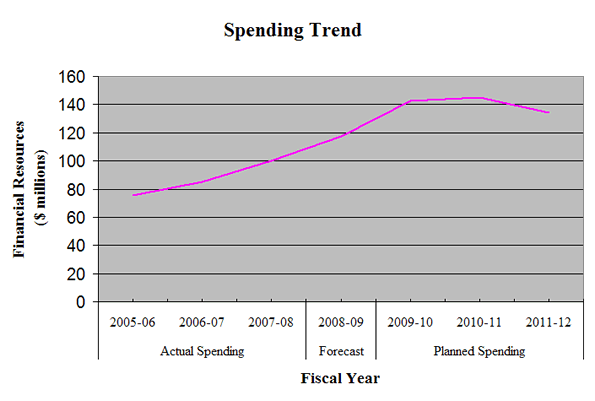
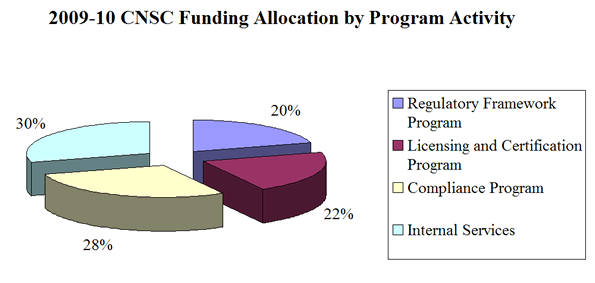
| ($ thousands) | |||
|---|---|---|---|
| Vote or Statutory Item | Truncated Vote or Statutory Wording | 2009-10 Main Estimates |
2008-09 Main Estimates |
| 15 | Program expenditures | 40,670 | 80,140 |
| (S) | Expenditures pursuant to paragraph 29.1(1) of the Financial Administration Act | 97,597 | - |
| (S) | Contributions to employee benefit plans | 4,464 | 10,040 |
| Total Agency (As displayed in the Main Estimates)* | 142,731 | 90,180 | |
* In 2009-10 the CNSC will be entering the second phase of transition to a revenue spending authority regime that will represent the Commission’s primary source of funding. This authority, pursuant to section 29.1(1) of the Financial Administration Act, permits the CNSC to recover and re-spend the full cost of regulatory activities performed on behalf of fee-paying licensees. In 2008-09 the CNSC received approval in Supplementary Estimates to begin phase I of the Revenue Spending Authority. Revenues for 2008-09 under this authority are estimated at $19.6 million.
